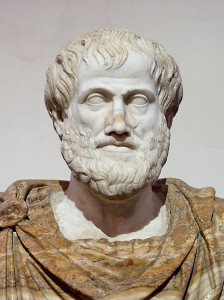The new concept of body and mind in theory of postmodern movies or postmodern theater
To understand modern cinema we will now look at some philosophical ideas that became really important for modern films with the following article. If you read all 4 articles above starting with Film Theories you will get a good understanding on modern films (so bookmark this page).
What all movies are about

Aristotle, greek scientist teaching theater theories at an ancient greek university 2500 yers ago. The coat was added later to the statue.
What is the aim of movies or theater. It is to help the viewer to be caring. Really this is the most important thing that you have to keep in mind if you want to make movies or books or theater or anything similar. Helping the viewer to be caring is the formost goal of any movie. It is the help in being caring that you sell. This is what is going to sell. The greeks wrote this down 2500 years ago about their theater in a very famous book called Poetics(links to Wikipedia). And for example the german poet Schiller wrote once more that this is true 200 years ago. This is the basic point of your focus if you want to make tv or movies or theater or anything similar. Help the viewer to be caring more easily. That is the only thing viewers will want.

German poet and playwright Friedrich von Schiller. Very famous. Talked in his theater theories about how theater has to help people to be more caring.Most people who make art know this, but those who don’t will fail.
Got it, help in being more caring, nice and friendly is what your movie offers.
Being caring is at the core of most religions. It is the central wish, and thats why all movies are about this. Help in this field is what people want if they watch fictional movies or read fictional books.
The mind and the body
Now we come to a very central point in thinking about postmodern movies. Well, we have seen that postmodern movies are not judged by their story. And they are also not judged by their filmic style. But since postmodern movies or theater are still movies the main rule still is valid. Postmodern movies or postmodern theater is juged by how much it helps the viewer to be caring. The ability to be more caring that the viewer gets by watching the postmodern movie that determins how good a movie is that has not changed in postmodern thinking.
Years ago there was the tendency to think of body and mind as something different from each other. People believed that they have a body and in this body a mind. And the mind was often thought of as the eternal part of us that is put into the body by God.
We have to take care here because the connection between body and mind has always been considered in our history. But lets just assume that in earlier times body and mind where thought of as tendentially differentiated.
In modern day the connection between body and mind has been thought over. And tendentially it has gone to thinking that the mind and the body are more connected. The mind is thought of as something triggered by the body. The mind is considered something bodylike and the body is considered something mindlike.So the thinking goes tendentially from mind-body-dualism to a thinking called embodied mind. Important thinker of this was Henri Bergson. Before we move on to this concept of Bergson and others and how it is important to modern movie and theater making I must make a hint at an issue that first becomes striking when you go deeper into this theory. So this is kind of a precaution to just drop a hint at the at question now. And that is that this tendentially newer body and mind concept is not an objection against God or Allah as it could wrongly be understood at a certain point. Even though we tendentielly think the mind as something that comes from the body still God is thought as something that spawns both things. So with our change in thinking we also lift God up and do not say that he does not exist, that would be the wrong conclusion. Now that we have addressed that issue that as I said could come to your mind at a later time with these body theories we go back to the change that took place in philosophical thinking about the body and the mind. So since roughly a hundred years philosophy is thinking of a concept called “embodied mind”. And that concepts states that mind and body are themselves things that can be experienced but not be described. Or better that any description of these things does not match what they really feel like. So the description in words about what you think does in modern thinking not at all describe what you think. Because what you think is something that you are and you can be it and feel it but it is generally different to the description. And with this this theory complex describes a mind that is like the body and vice versa it defines the body as having mind like qualities. A mindlike body states that being with your body is something that you can feel through and through and which is something true, but which also can not be described with the mind. What the body is, is now described as like the mind, you can be it but you can not find words for this it is just not describable what you are at the moment with your body. That was Bergsons theoretical approach. And also we say you can describe what you think with your mind, but the form, what you really are at this moment with your mind, that can be sensed by you but also can not be described. So Bersons theories and of course many other philosophers in that time and later speak of it that mind and body are there and you feel them and you feel yourself in the moment of having them both, but this what you are with both can not be described. Or lets say a description even if it carries the meaning that you really expressed does not carry the complete meaning of what you are in that moment. So logic does not keep up with this undescribable “being of body and mind” and word logic does also not keep up with what happens when you see a person. So actually for movies this says that the things you see on stage have much more effects then what the story delivers to the viever. And taking a closer look at these effects that also happen, that is a big aspect in postmodern film, theater and movie theory.
So what does this change in thinking mean for our movies?
The mind is now something that can have a form, a state. So for example if you present a hero in your movie that in the end does the good thing and is caring and helps everybody. Then the viewer does not only think that helping people is a good idea, his mind has changed. his mind has now a different “form”. His or her mind is now in a form that wants to be more caring.
That is an important change in theory. Now you are able to understand what the viewer thinks as a form, a state. So you can not only give the viewer stuff to think about, you can build forms of his thinking that adjust him towards being caring and nice. Film always did this, but now we have a different way of understanding this.
That comes from the idea that the mind is like the body. and that a certain form of the mind makes it easier for the viewer to run automaticaly on the track of caring and helping.
What we can see here is that film or theater does not only bring the understanding that being caring is something nice. We do not only understand this with logical thinking. We are formed. Our mind is formed by wittnessing that being caring brings advantages. It is a difference to understanding. This is more like becoming something. And this is one of the important shifts from modern movie theories to postmodern movie or theater theories. Coming from describing what happens in a film from something that is explainable to something that you can be but not explain with word. So with this new idea that we offer forms for the mind we have a powerful tool to help the people to be more caring. They don’t just understand that it will be good to be caring and nice, their mind will be formed to do it by itself. So this is the idea that the mind reacts directly to the movie or theater and does not at first think about it. It is as I said the same thing that movies always did, but now we understand it better. We understand that talking to the mind is not talking to the logic, but much rather we exercise and form the mind.
The body in postmodern movies
For the body now this theoretical approach means the following. Of course a relaxed body is the base of a relaxed mind. As I said in the previous chapter an action movie is a completely valid form of movie. Imagine a scene of shooting, running or car chases. This has an effect on your body and this effect brings the body into a form of focusation and attention. And this gives the body a good base for being caring.
Lets have a look at Game of Thrones again. Watching Game of Thrones brings you into the feeling that the king could have you killed by his guards if he just says to his guards kill that man. And he will not be punished for this. This puts you in a state of body and a state of mind. A very humble state. Now understand how this state makes it easy for you to meet the people around you with humble caring. This show puts you into a state that makes it easy for you to be caring. The show is not about thinking about politics, it is about direct effect on the mind and body. All postmodern movies and theater search for this idea of direct and helpful effects on the mind and the body. Postmodern thinking is about bringing the viewer into states that make being caring more easy.
A very humble state. Now understand how this state makes it easy for you to meet the people around you with humble caring. This show puts you into a state that makes it easy for you to be caring. The show is not about thinking about politics, it is about direct effect on the mind and body. All postmodern movies and theater search for this idea of direct and helpful effects on the mind and the body. Postmodern thinking is about bringing the viewer into states that make being caring more easy.
Now note how the form of the body of the viewer can be formed in various ways. You have a scene of a certain mood, with the set and the lighting you create a mood of the scene and this directly effects the body. In postmodern movie theories you directly aim at the body and the mind of the viewer. But you do not only have the mood of the scene. You also have the actor in the scene, that has multiple ways of reaching the body of the spectator. Look at what happens if you hold your body in a position that makes somebody you talk to to go into a position intuitivly. So you see that always people are influenced in their position by your position. And if you consider thatand also consider that with a good body position you can be more caring this means that there are also body positions that have an effect on the body position of the people that see you which bring them into a body position that is good for being caring. Remember you can not force the position change of other people. If they don’t want to react on your form of the body they will not do it. Also good to know is that no form of the body makes you bad or wrong in a religious sense. And most important, trying to give yourself advantages through the backdoor of tricking people and forming the body forms of the people around you with a certain body form you make, will not bring you to anything. In the end you can not cheat God or Allah or the System. Only forming your Body to form the body of the others to be caring more easy is a step into the right direction.
So you can do a form of the body towards which other people react with a relaxed or otherwise positive form of their body. Or you can do a form of the body that is so good that others have not yet known it and then can learn it. If you want to experiment with this , know that trying to be caring and nice lets you always be automaticly in the best movements for all aspects. So with the wish to do the most caring thing you will act out the best movement that is possible in this situation.
What does this mean for movie theories? Now imagine the possibilities of the actor not only to play the character but also let the viewer have a reaction to the posture of that actor to form a good body form or even teach a body form the viewer did not think about much. Again, actors of all ages knew of these possibilities.
That all together is why many postmodern movies prefer a friendly lighting of the scenes. To have the viewer relaxed all the time.
But in your movie you do not only have the mood of the scene and the actor and his possibilities.
The scene
You have two more things. Surroundings and Story.
The surroundings are two things: First we think of the physical being there of the objects. Remember you might position yourself differently between different objects. Just imagine a big massive steal rig or a wood table. You might stand differently if you stand near these objects. And the same will happen if the viewer sees objects in the tv. He will react to them. Not exactly as if he stands beside them, but he will think a bit that he is close to these things. Only that he will know that it is theater.
And this also combines with the lighting of the scene.
 And then you have the “”society”" or story surroundings. What is this fictional world like? Is it friendly, are there dangers? How should I move?
And then you have the “”society”" or story surroundings. What is this fictional world like? Is it friendly, are there dangers? How should I move?
And then you have the Story. In what situation are we in. What should happen and what should not happen. How friendly is this character?
This all influences the body and the mind. And it influences the mind through the body. And it influences the body itself directly because it is thought with theories like Bergsons that the body form is also a part of the viewers life. But always only as much as the viewer is willing to adapt to the movie.
And to all that keep in mind that teaching better movement by presenting better “movement” of the mind and of the body could also be transmitted with the scene.and the mood.
There are some serials from the eighties like A-team, Riptide, The Fallguy or Knight Rider and these series are very friendly. Some people think that this is flat and stupid because it has little drama. But it is not flat, it is constructed with this knowledge of putting the viewer into a relaxed mood.
So this part of postmodern movie theories or theater theories gives us the possibility to not only talk about being caring in our movies, but also teach physical methods or bring the viewer into physical states of the body or states of the mind from which he or she can be more caring.
So that is what is meant with the idea that in postmodern thinking and theories the effects on the body and the mind are more direct. It is meant that you do not think about the work of art and then change your mind but that body and mind change directly when they see the work of art. And it is the idea to become able to better work with this direct effects.
Final thought on this modern aspect of postmodern film theories
These thoughts of the right way of movement sooner or later lead to the question of perfection of movement. An important question is, is there the perfect movement. Because if there is the perfect movement then there is the perfect theater or perfect movie that makes the people perfect when they watch it. So the question is is there holy movement that people can learn. An important question in higher modern theater theories.
It is all part of the question: is perfection something that we do with our bodys and that can be taught with movements on Tv. And the answer to that is: No, what we do in terms of perfection does not depend on movement. That is very important. You must not have certain movement. It is not our bad way of moving that makes us being away from God. No, no. You do not have to consider movement so strong. The world has much more complicated “folds” where there is more to understand then just the movement of things. So practicing movement or influencing movement by making tv or other art is very nice. But it is not everything. This world will not come to a world and doing that depends on the right movement of the body. And so a changing of others with your movement is in no second necessary. You will reach perfection even without a certain movement. So don’t ever mind to much about moving in a way that helps others to move better. And of course don’t bother to much about making theater with perfect movements that make people move perfectly when they see it, because this will never exist. Performances consider strongly today as I said the physical movement deriving from the physical movement that the spectator sees. But this is not needed. This is not the ltimate way for theater as some theoretical thinkers have thought, like Artaud for example. There is nothing like the perfect theater that consists of perfect or holy movements. Is no not the aim of theater to become perfect in its movement because we do not need movement for perfection. Yet we see that movement can be improved. So that makes it usefull for theater to show improved movement but at the same time it is not usefull to think that there is a perfect theater. Making the movement of the viewer that he or she has in reaction to the theater is very useful theory but deriving from this the idea of perfect theater or film is not usefull because perfection is not dependent on movement.
No, perfect movement is not the way to perfection.
But movement is good for expressing thngs, have an influence on people, and move the environment. So or body attitude constantly moves the environment and us and with this the future of the universe. But nevertheless this movement of the universe with our body does not become decisive. It does not matter overall. We can be perfect at the moment without making a movement that makes the future perfect. So we are free to do with our movement what we want. And we can do with our “body attitude” what we want.”"Body attitude”" is the way we think about things. The way we literally “stand” towards things. The way we stand and hold our body according to our attitude about life and the world. So this “body attitude” that all theater of all times tried to make better is not making us perfect. You can live without it.So trying to make everything in our own perfection happen just with the way we move will lead us to nowhere. And therefore it is also not a good Idea to make movement the only thing in theater or film. But yet it is great to make Theater or film much about movement and the movement of the viewer in body and mind that comes from the movements of the film or theater.
Further reading. There is a third chapter on this page for modern film or movie theories.
